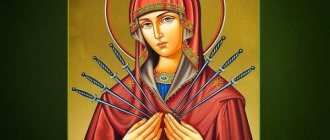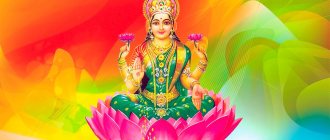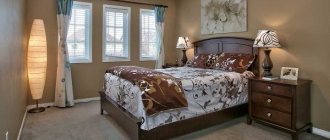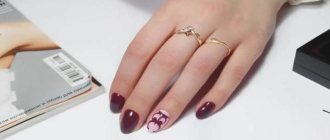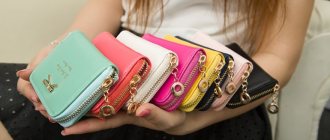- Tweet
- Share 0
- VKontakte
Logo color is one of the key elements of a strong brand. Each color has its own characteristics, associations and psychological effects. By choosing a color or combination of colors for your logo, you also gain these associations.
Colors evoke certain emotions and feelings, so it is extremely important to choose a color that effectively represents your personality.
Research shows that people subconsciously form an opinion about a person, environment or product within the first 90 seconds, and that 62% to 90% of this assessment is based on color alone.
Understanding the psychology of color is vital when creating an effective logo - Martin Christie of Logo Design London.
How important is the color of the logo?
The corporate color of the logo is very important! Let's take, for example, the popular McDonald's logo and play with color (may the designers forgive us):
Even though we didn't change the design at all, the color change turned a well-known brand into something completely different. And this is something not entirely appetizing.
We can do the same exercise with the Coca-Cola logo:
You don’t really want to take such a jar of a delicious drink, do you?
The biohazard sign takes on a completely different meaning when shown in Barbie colors or the colors of environmentally friendly materials:
Even when explicit verbal commands are included, conflicting color symbolism can be misleading.
Just change the color of stop signs to green and it will cause accidents at every intersection. So it’s safe to say that brand colors are very important.
So how do you choose a color to create a logo?
Color meaning
Let's take a look at how 100 of the world's most popular brands use color in their logos. These companies spend millions, if not billions, on marketing and brand development, and they still know a thing or two about the colors they use.
Here are some charts that show statistics on color usage by well-known companies:
What do we see? Most popular brands are monochrome - they use one color. The most used color is shades of blue, followed (ironically) by black. The last color on the list, purple, is a risky decision. Now that we've cleared that up a bit, let's look at the psychology of different colors - from the most popular to the least popular - and see how famous corporations and brands use them.
Blue color
Meaning : Trust, conservatism, reliability, honesty, calm, strength, coldness. Notable : Most popular corporate color. Often used for online businesses and financial institutions. Masculine color.
Black color
Meaning : Sophistication, luxury, formality, style, elegance, high cost, authority. Notable : Black is used for “high end” brands, either as a base or paired with another color. Black is gloomy and serious. Most logos were first designed in black and white.
Red color
Meaning : Courage, passion, strength, attention, love, delight, action, aggressiveness. Notable : Red works equally well on black and white backgrounds. It can mean stop, danger and hot. Exclamation color. Pink colors (shades of red) are considered to be feminine colors.
Yellow
Meaning : Logical, optimistic, progressive, confident, playful, creative. Notable : Yellow is usually too bright to be used alone and requires the use of an outline, background, or border color. This is the color of caution. Represents clarity.
Orange color
Meaning : Happy, energetic, sociable, friendly, approachable, enthusiastic, sunny. Notable : Orange is believed to stimulate appetite. The color orange is used in some warning signs. Often used in retail. Typically this is a call to action.
Green color
Meaning : Nature, wealth, freshness, life, harmony, environment, growth, newness. Notable : Green means “forward.” Often used to represent eco-friendly companies and products. Considered a calming color.
Purple
Meaning : Royalty, mystery, pomp, ceremony, creativity, uniqueness, majesty. Notable : Once the most expensive color to produce, as it was made from a rare seaweed. Often seen as elite. Children like it and are often used in packaging sweets and toys.
Red
The color red speaks of danger, excitement, passion, strength, aggression and success. This is not only an emotional, but also a physiological reaction. The color red causes shock, it completely captures attention and requires effort to perceive. Focusing on the color red increases your heart rate and blood pressure. Ever wonder why so many fast food restaurants are painted red? This color activates the salivary glands, which makes us hungry and tires our eyes, causing us to eat more and then leave the room faster.
Red color is more noticeable than others. Due to its powerful effects on your peripheral nervous system, red can make you restless and restless. Casino owners have noticed that when the color is red, people make more bets and play more riskily, and therefore it is used in sectors where they play for high stakes. Red encourages people to make quick decisions.
The color red also fills you with energy and courage, giving you a feeling of strength with which you can accomplish your goals. This is why politicians often wear red ties, especially before presidential elections. Red evokes strong emotions, including passion. After all, there are red light districts. A woman in red is often seen as flirtatious; game.
In China, the color red means good luck; Brides are dressed in it, and newborns are greeted with red eggs. Feng Shui proponents recommend using the color red to drive away bad energy from your home. But there are restrictions on red in home decor: use it only in rooms where you'll be working or hanging out - living rooms (if you're using red for the dining room, be prepared for guests to eat twice as much). Red color is preferable for passage areas where you do not need to spend a lot of time - in halls and corridors. In a nursery, it can lead to insomnia.
Red is ideal for drawing attention to advertising and safety products, from Cambell soup cans to fire extinguishers. Rich red is a color that expresses speed, power, play, danger and passion. Red grabs attention and brings objects colored in it to the foreground. Red creates a feeling of warmth. Coffee seems hotter in a red cup than in a green one. Red is the first color you'll lose sight of at dusk; it is not visible at long distances.
Combination of colors in the logo
Now that we understand the psychological effects of colors, let's look at how to choose a color for a logo.
We can choose from a range of classic palettes from the color wheel that artists have used for centuries to create balanced and visually pleasing (or high-contrast and vibrant) compositions. In most design applications, these color schemes should be divided into one dominant color (dominant either because of how much it appears in the design or because it stands out when compared to other colors) and one or more complementary colors.
There are several ways to choose a color:
1) Monochrome colors. Various shades, tones of the same color are used, for example, the spectrum of blue, ranging from light to dark. This type of scheme is more subtle and conservative (see picture of the top 100 brands above).
2) Similar colors. Shades that are adjacent on the color wheel. This type of diagram is versatile and easy to use for design development.
3) Complementary (complementary) colors. Opposites on the color wheel, such as red/green or blue/orange; Complementary colors with high contrast and high intensity, but they can be difficult to apply in a balanced and harmonious manner (especially in their pure form, where they can easily clash in a design).
4) Separate-complementary. Any color on the color wheel plus two flanking colors. This scheme has a strong visual contrast, but less sharp than in a complementary combination.
5) Triadic. Any three colors that are the same distance from each other.
6) Tetrad/Doubly complementary. Two pairs that complement each other; This scheme is very attractive, but can be even more difficult than applying one pair of complementary colors, since more colors are more difficult to balance. If you use this type of scheme, you choose one dominant color out of four, and adjust the saturation/value/etc. of some or all of the colors so they work well in different parts of your design, text, and background.
Grey
The most accurate definition of gray is neutrality. It's rare that someone either loves or hates this color. Gray does not proclaim itself to be loyal and trustworthy, like aqua, or that it is dynamic, like red. Gray is unemotional, formal and dignified.
Gray lacks warmth, which makes it look detached and solemn. It brings to mind skyscrapers, churches and cemeteries.
This freedom from emotional stimulants gives him an aura of power and wealth. Gray is a must-have color in a business person’s wardrobe, for example in the form of a formal suit with thin anthracite stripes. Perhaps it is for this reason that prosecutors try not to come to courtrooms in gray suits, so as not to overwhelm the jurors drawn from ordinary people with their appearance.
The icy coldness emanating from the gray color determines its use in decorating office interiors. This color cannot be classified as either friendly or repulsive; it simply inspires a feeling of success and reliability.
Gray is associated with maturity and wisdom. It is believed that people with gray hair have gained knowledge and experience.
Designers developing packaging models are attracted to gray color due to its richness of shades and prestige. For luxury cars, silver shades are now chosen, similar to the color of platinum credit cards. Boutiques use gray boxes for packaging, thereby suggesting that there are expensive gifts inside.
The metallic gray color is associated with progress in science and technology, which is why it is used when presenting high-tech products. The best seller of expensive luxury cars is color, as it indicates the engineering marvels that can be found under the hood.
It is undeniable that there is a connection between the color silver and speed, and this is reflected in car advertising.
In interior design, dark gray can look dull. Light gray is more welcoming, but none of its shades will be conducive to a friendly conversation. Shades of gray suit rooms where people usually gather to relax peacefully.
The reaction to gray in the home depends on the climate. If the house is located in a foggy and rainy area, then gray rooms will look depressing.
So think carefully before painting your dining room walls gray, especially dark shades. It may not be devoid of elegance, but it won’t add to your appetite. The color gray is associated with impartiality, formalism, arrogance and conservatism. Unlike neutral brown, gray lacks warmth, making it distant, solemn, and sometimes dull. The color gray is associated with wisdom and maturity. Metallic gray is associated with ideas of progress, speed and professionalism. In a home environment, gray looks cool and calming, but is not conducive to friendly conversation or appetite.
How to choose a color
View this
to quickly remember the meaning of each color. Ask yourself the following questions:
Which color represents the essence of your brand?
Colors are not tied to a particular area of the economy - although some are more or less suitable for certain products or services. Your goal should be to choose a color that will best suit your business. The color that will give the best impression of your product at first glance.
Which color suits the characteristics of your product or services?
What logo color are your competitors using?
Choose a color opposite to your competitor's. The color of your opponent is probably the most important thing to take into account. If you are a pioneer in your industry or market segment, you can choose first. Choose a color that represents your product and its uniqueness. If you are second, it means someone has already made the first choice. Instead of choosing the same or similar color, choose the opposite one. Choose blue if your competitor has red, choose purple if they have yellow, etc. The power of a brand lies in its ability to stand out. Choosing the same color as your main competitor gives the impression of copying it. You want to separate yourself from your competitor, you want to show that you are different.
Don't limit yourself to one color
Some brands, like eBay, choose multiple colors for their logo. You can also choose a couple of colors that look good together, but there is a risk of getting it wrong. Therefore, it is best to use 1-3 logo colors.
Be aware of differences in cultural perception of your color
For example, in the Western world, white is considered the color of purity and peace, but in some parts of Asia, white is the color of death. Make sure the color you choose will create the right impression on your target audience.
Entertainment summary “What color is happiness?”
Vishnevetskaya Margarita Ivanovna
Entertainment summary “What color is happiness?”
1 Purpose of the lesson: To consolidate the ability to express a certain mood through color , to show an emotional state with facial expressions, to encourage the creation of a joyful mood, to learn to convey various emotions through music, color , and masks.
2 Tasks:
Educational: Offer to guess the different moods of fairy-tale characters on the slides. Get complete answers.
Developmental : Develop cognitive interest
Educational: Cultivate positive emotions.
Previous work: conversation, listening to music, work in the psychological corner “Guess the mood”
, looking at various illustrations.
Vocabulary work: facial expressions, mask, happiness , mood, heroes.
Methods and techniques: examination, showing, conversation, analysis, encouraging questions. Equipment: sheets of paper with drawn patterns, pencils, chamfers, drawings depicting happiness , sadness, fear, masks depicting different emotional states.
Individual work: Conversation with Arina T. about positive emotions.
3 Forms of work for pupils: Individual.
4 Equipment: Masks, drawing paper, pencils, paints.
5Structure and course of the lesson:
Move
Voel: - Children, today we are going on a very interesting journey to find out what color happiness is . Take your seats on the plane.
While they're flying
The teacher explains to the children what a mood is,
what it is like , what it depends on, and what happiness . happiness means for every child , what he understands by this word. What kind of mood do they like, theirs, those around them (listens to the children’s answers)
.
Vos-l suggests depicting happiness . Then he shows how it can be drawn. Includes an audio cassette with a recording of the French song “Dance of the Little Ducklings, (translated by Yu. Entin)
.
To this music, children draw a happy expression on their faces . Selects the appropriate color and paints the person’s dress.
The teacher turns on the following melody - the song “The Dog is Missing”
(V. Shainsky - A. Nash)
. Asks the children:
what mood does the song create? (Sad)
. Shows how you can draw sadness: the eyebrows are not raised, the eyes are sad, the corners of the mouth are lowered down.
Vos_l - Which color is best for depicting a sad mood?
Children: Gray.
To illustrate the evil mood, the “Song of the Robbers”
(G. Gladkov - Yu. Zntin)
: the corners of the kirta are lowered, but the eyes and eyebrows are not calm like a sad person, but tense.
Voss: Children, let's choose a color for the evil person ?
Children: - Black is suitable for an evil person ,
Phys. just a minute. "Dance of little ducks"
.
Next, the children sit in a circle. The teacher shows masks depicting different emotional states: sadness, joy, surprise, suffering, fear. Children reproduce these states with facial expressions. After this, the masks are passed around in a circle.
Vos_l: - Children, today I have prepared different masks for you. Look at them. What kind of mask is this? Happy or sad? And this? I will put on a mask and look at you, and you will be my mirrors. If I'm wearing a sad mask, then you would make your faces sad. You are sad too. That's how many mirrors we got! And now we will act without words. I put on a mask, and you are my mirrors.
Now Masha has a mask on her face, and you all turn into Mirror Machines. The mask goes to Dima. (Then the masks are removed.)
Voe-l: - Children, remember what expression Barmaley had on his face? Show me the little bun that was merrily running along the path? You have turned into the Princess - Nesmeyana, the sly fox, into Pinocchio!
Next, the children are divided into two groups. The leader joins each group in turn. The first group agrees which hero they are showing, the second guesses. Then the groups change. Vos-l offers to guess which of the fairy-tale characters has such an expression on the egg. How did you guess?
Then the soldier gives the command to climb up the plane’s steps into the cabin, and we’re off to the kindergarten. On the way to the kindergarten, the teacher conducts a conversation with the child passengers on the following questions:
Which mask do you like best?
Which hero do you want to show again?
What facial expression do you like to see on your friend, mother, teacher? Show.
What expression on your face is pleasing to other people? Show.
Voel: -And so the plane landed. Did you enjoy the trip? We will send more! next time. And now I suggest you draw a happy expression on your face , and we will all find out what color happiness is . They are considering.
Voss: - Well done. (They find a treat from the ship’s commander and distribute it to the children.)
Psychology of color in marketing
Brand recognition is closely related to color. Just think of Coca-Cola, Facebook or Starbucks and I bet you can immediately name the colors they are associated with. A University of Winnipeg study on "The Impact of Color on Marketing" found that the first judgment about a product is based on color (60-90%, in the first 90 seconds). This means that in design, color is not only an artistic choice, but also an important business decision that affects everything from consumer perception to product sales.
But when choosing a color scheme for a logo or brand, don't be tied to any traditional, symbolic or stereotypical methods. When it comes to color, there is no simple process or strict rule. The most important thing is the color itself and how it is used in the design - whether it suits the brand and the market context. For inspiration, check out BrandColors, a site that provides a visual guide (with hex colors) to the color choices made by famous brands around the world.
Color matching services
Adobe Color CC
Adobe Color CC lets you try, create, and save different color schemes, each consisting of a set of five colors. It is available in browser and desktop versions. If you're using the desktop version, you can export your color scheme directly into Photoshop, Illustrator, and InDesign.
Mudcube Color Sphere
If you're unsure about your color scheme, Mudcube has a selection of themes to choose from. Mudcube Color Sphere is a handy little color resource for designers because it not only provides HEX numbers for each color, but also helps you create a color scheme from a single selected hue. If you're undecided on what color scheme you should choose, MudCube will provide a theme selection from a drop-down menu.
Other services
Color Palette Generator is a free online service that allows you to generate a color palette based on an uploaded file in PNG, JPG or GIF format.
ColorZilla – Using Colorzilla, you can use an eyedropper to take a color from anywhere in your browser and determine its number. An indispensable item for designers.
Material UI Colors is a color palette for Android, web and iOS in the style of material design. Brand Colors – colors used by famous brands.
COLOURlovers – the library of this web resource includes more than 2 million ready-made color solutions, which can be sorted by rating, number of views and date of creation.
Colorscheme is a professional online service that allows you to generate a color scheme in accordance with the rules of color on the color wheel.
0 to 255 – this service will allow you to view all possible shades and find the one that suits you.
More services for working with color here.
Now that you have learned how to choose a logo color, you can move on to creating it.
Need more tips? Read article 63 for expert advice on how to create a logo.
